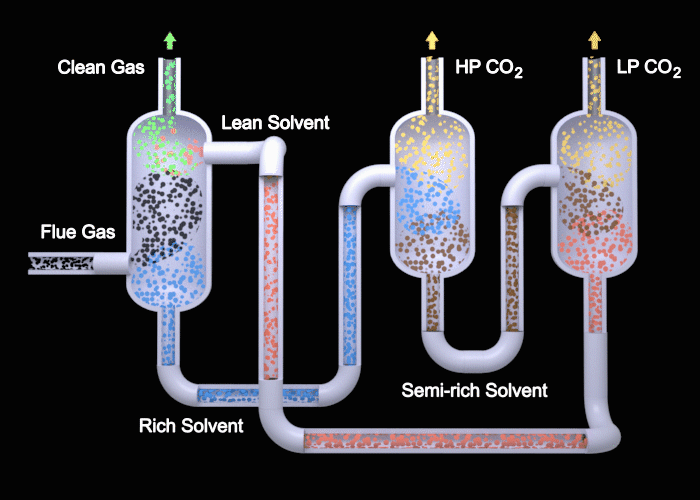2021/3/11 アメリカ合衆国・パシフィック・ノースウェスト国立研究所(PNNL)

・ PNNL、Flour Corp.および Electric Power Research Institute が、EEMPA として知られる水分含有量の少ない低粘性の溶媒で CO2 を捕獲する技術を実証。
・ 現行の商用技術のコストを 19%、エネルギー消費量を 17%削減しながら現行技術と同様のタスクを遂行。また、既存の捕獲システムに容易に導入できる。
・ 炭素捕獲技術は、アミン水溶液による吸収法からエネルギー効率的なメンブレンによるフィルタリングまで多岐にわたる。アミン吸収による現行の商用技術では、4 億~5 億ドル/ユニットのコストで、CO2 を 1 トン当たり約 58.30 ドルで捕獲(米国エネルギー省(DOE)分析)。EEMPA は、発電所の燃焼排ガスから CO2 を 1 トン当たり 47.10 ドルで捕獲し、後に高純度の CO2 として回収する。
・ 本研究では、1930 年開発当時のようなシンプルな CO2 捕獲技術から多段階の複雑な技術において、EEMPA を利用する際に発電所が導入可能な 7 件のプロセスについて説明。550 メガワットの石炭火力発電所にてこれらのプロセスを実施する際のエネルギーと材料コストをモデル化し、各技術による 1 トン当たりの CO2 捕獲コストがほぼ 47.10 ドルの水準であることを確認した。
・ 燃焼排ガスからの CO2 を捕獲する化学プロセスは開発当時からほとんど変わらず、アミン水溶液と燃焼排ガスを混合して CO2 を吸収後、圧縮・貯蔵する。ただし、アミン水溶液は水分を多く含有するため、CO2 の除去には高温度での煮沸、その後の再利用には冷却が必要となりコストが増大する。
・ PNNL では、2009 年に水分の含有量をより少なくした溶媒の開発を開始。高粘性の課題についてEEMPA では 99%低減し、現在では商用の水溶液とほぼ同等となり、大部分が鉄鋼で構築される既存インフラで利用できるようになった。
・ また、水溶液に長期間晒されて腐食する高価な鉄鋼をプラスチックで代替することで重量を 1/10 に低減し、1 トン当たり 5 ドルの全体コストの追加的削減が可能であることを 2019 年実施の研究で確認。プラスチックシステムでは、EEMPA の反応表面が強化されることが追加的な利点となる。
・ Electric Power Research Institute が率いる Research Triangle Institute International とのプロジェク
トでの、National Carbon Capture Center(NCCC)内の 0.5 メガワット規模試験設備での分析に向け、2022 年に 4,000 ガロンの EEMPA 製造を予定。2035 年までに 1 トン当たり 30 ドルの CO2 捕獲技術の商用化(DOE 目標)の達成を目指して EEMPA の研究開発を継続して実施する。
・ 本研究には、DOE の化石エネルギー部が資金を提供した。
URL: https://www.pnnl.gov/news-media/cheaper-carbon-capture-way
<NEDO海外技術情報より>
(関連情報)
International Journal of Greenhouse Gas Control 掲載論文((アブストラクトのみ:全文は有料)
Techno-economic comparison of various process configurations for post-combustion carbon capture
using a single-component water-lean solven
URL: https://www.sciencedirect.com/science/article/abs/pii/S1750583621000311?via%3Dihub
Abstract
Aqueous amines-based absorption is the most mature and scalable technology for post-combustion carbon capture, but subject to high energy and capital investment costs. Water-lean solvents, with associated advanced process configurations, show promise of significantly reducing both energy and capital costs via lower solvent recirculation and lower water condensation and vaporization. Even though advanced process configurations have been intensively studied for aqueous amines, few discussions can be found in the open literature for water-lean solvents. In order to fill the gap, the present study focuses on the process designs towards lower carbon capture cost enabled by water-lean solvents. N-(2-ethoxyethyl)-3-morpholinopropan-1-amine (EEMPA), a single-component water-lean solvent, was selected as an archetypical water-lean solvent. A property package was developed for the H2O−CO2-EEMPA system based on experimental data. Process models were developed in Aspen Plus for 90% CO2 capture in a 550 MW supercritical pulverized coal power plant, with optimal operating conditions determined by sensitivity studies. Techno-economic analyses were performed to compare seven process configurations: simple stripper, two-stage flash, lean vapor compression, inter-heated column, advanced flash stripper, low-pressure steam heater, and advanced heat integration. The results show a two-stage flash configuration, has a carbon capture cost of $47.1/tonne CO2 (in 2011 US dollars), about 19% lower than the industrial benchmark, Cansolv. While considerable capture cost reductions have been proven for aqueous amine using lean vapor compressor and advanced flash stripper, those configurations were shown to have negligible impacts with water-lean solvents due to differences in solvent’s physical properties.



